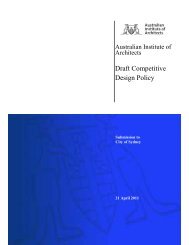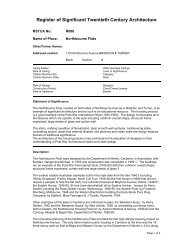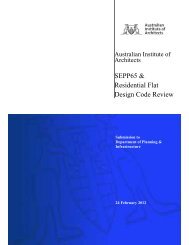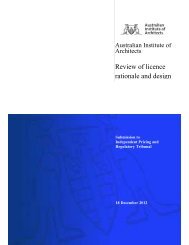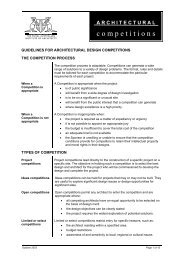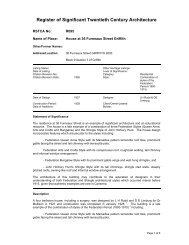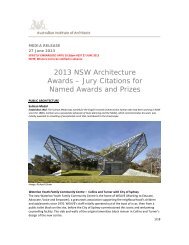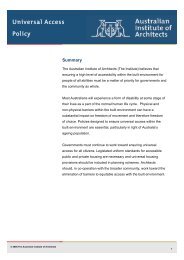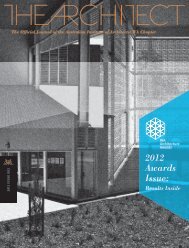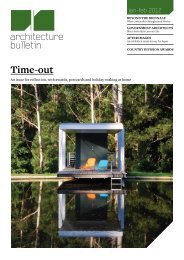Small Lots Housing Code - Australian Institute of Architects
Small Lots Housing Code - Australian Institute of Architects
Small Lots Housing Code - Australian Institute of Architects
Create successful ePaper yourself
Turn your PDF publications into a flip-book with our unique Google optimized e-Paper software.
INTRODUCTIONThe <strong>Institute</strong> welcomes the opportunity to comment on the proposedextension <strong>of</strong> the General <strong>Housing</strong> <strong>Code</strong> and the introduction <strong>of</strong> a <strong>Small</strong> <strong>Lots</strong><strong>Code</strong>.The <strong>Institute</strong> enthusiastically supports the introduction <strong>of</strong> exempt andcomplying codes in general, and the NSW <strong>Housing</strong> <strong>Code</strong> in particular. Thecodes are an important means <strong>of</strong> providing greater simplicity and certainty forcertain types <strong>of</strong> housing developments.We therefore welcome both the proposed extension <strong>of</strong> the general code toapply to lots with a minimum area <strong>of</strong> 300m 2 and a primary road boundary <strong>of</strong> atleast 10m and the proposal to introduce a small lots code to apply to lots 6-10metres wide and a lot area <strong>of</strong> at least 200 m 2 .We raise the following matters for the Department’s consideration:1 RELATIONSHIP BETWEEN COMPLYING CODES ANDOTHER PLANNING INSTRUMENTSWe note that the widespread adoption <strong>of</strong> the small lots housing code andgeneral housing code will be, in effect, to create new statewide minimumdevelopment standards for housing, as well as a benchmark against which toassess the effectiveness <strong>of</strong> new standard LEPs and DCPs. We envisage andsupport a future planning regime in which the <strong>Code</strong> SEPP provides the globalcontrols for certain types <strong>of</strong> development in an area, while DCPs providefurther detail on nominated site-specific issues. If this proposal is adopted webelieve that merit assessment <strong>of</strong> a proposal (through a developmentapplication) could then be assessed against the same development standardsas the <strong>Code</strong>s SEPP.We understand that the Department’s consultant has prepared a paper on therelationship between the codes and DCPs, as well as setting out a process forthe assessment <strong>of</strong> minor variations to the code. Similar processes arecurrently operating in other states. As these matters have the potential t<strong>of</strong>urther improve the effectiveness <strong>of</strong> the NSW development assessmentsystem we urge the Department to circulate this paper widely to localgovernment and the relevant pr<strong>of</strong>essions for comment.We note the need to remove any conflicts between the <strong>Code</strong>s SEPP andLEPs, particularly in regard to LEP floor space ratios.The <strong>Institute</strong> supports the amendment <strong>of</strong> clause 1.18(2A) <strong>of</strong> the <strong>Code</strong>s SEPPin order to remove the conflict between the <strong>Code</strong>s SEPP and otherenvironmental planning instruments.<strong>Australian</strong> <strong>Institute</strong> <strong>of</strong> <strong>Architects</strong> (NSW)<strong>Small</strong> <strong>Lots</strong> <strong>Housing</strong> <strong>Code</strong>6 August 20101





